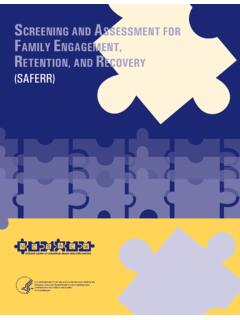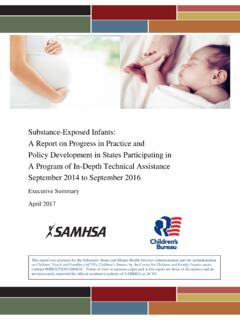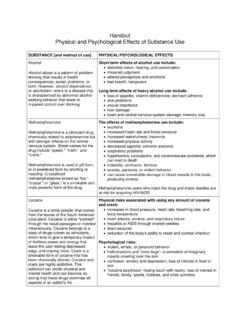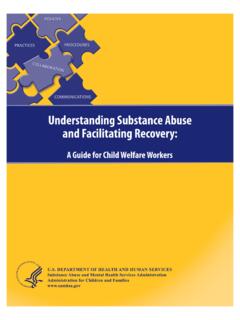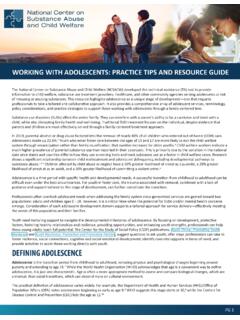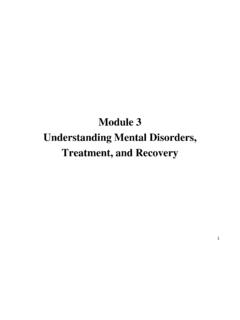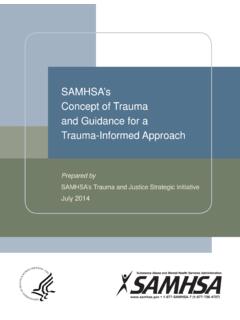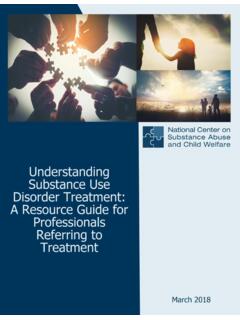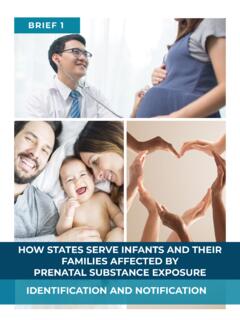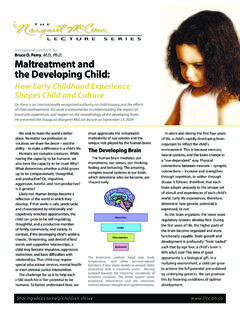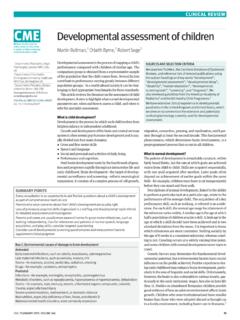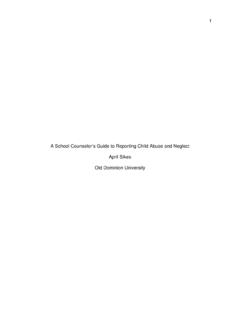Transcription of Drug Testing in Child Welfare: Practice and Policy ...
1 drug Testing in Child Welfare: Practice and Policy ConsiderationsiDrug Testing in Child Welfare: Practice and Policy ConsiderationsSubstance Abuse and Mental Health Services AdministrationCenter for Substance Abuse TreatmentAndAdministration for Children and FamiliesAdministration on Children, Youth and FamiliesChildren s BureauiiAcknowledgmentsThis document was prepared by the National Center on Substance Abuse and Child Welfare (NCSACW) under Contract No. 270-027108 for the Substance Abuse and Mental Health Services Administration (SAMHSA) and the Administration for Children and Families (ACF), both within the Department of Health and Human Services (HHS). Nancy K. Young, developed the document with assistance from SAMHSA s Center for Substance Abuse Prevention (CSAP). Sharon Amatetti, served as the Government Project Officer from the SAMHSA Center for Substance Abuse Treatment (CSAT) and Irene Bocella, served as the Project Officer from the ACF Children s views, opinions, and content of this publication are those of the authors and do not necessarily reflect the views, opinions, or policies of SAMHSA or HHS.
2 Resources listed in this document are not all-inclusive and inclusion in the list does not constitute an endorsement by SAMHSA or Domain NoticeAll material appearing in this document is in the public domain and may be reproduced or copied without the permission of SAMHSA. Citation of the source is appreciated. However, this publication may not be reproduced or distributed for a fee without the specific, written authorization of the Office of Communications, SAMHSA, Access and Copies of PublicationThis publication may be downloaded or ordered at Or call SAMHSA s Health Information Network at 1-877-SAMHSA-7 (1-877-726-4727) (English and Espanol). In addition, this publication can be ordered from the Child Welfare Information Gateway at CitationCenter for Substance Abuse Treatment. drug Testing in Child Welfare: Practice and Policy Considerations. HHS Pub. No. (SMA) 10-4556 Rockville, MD: Substance Abuse and Mental Health Services Administration, OfficeOffice of Program Analysis and Coordination, Center for Substance Abuse Treatment, Substance Abuse and Mental Health Services Administration, 1 Choke Cherry Road, Rockville, MD 20857 HHS Publication No.
3 (SMA) 10-4556iiiCONTENTSI. INTRODUCTION ..1II. CONSIDERATIONS FOR USING drug Testing ..2 Organization and Purpose of This Paper ..2 Agency Values and Mandates ..2 III. drug Testing CONSIDERATIONS ..6 Establishing a Collaborative Approach before Implementing drug Testing ..3 drug Testing in Substance Abuse Treatment and Child Welfare Programs ..3 drug Testing in Substance Abuse Treatment Settings ..4 drug Testing in Child Welfare Settings ..5 Determine Whom to Test ..6 Specimen Types ..6 Detection Window ..8 drug Testing Methods ..10IV. INCORPORATING drug Testing INTO Child WELFARE CASEWORK ..15 Discussing drug Testing With Parents ..15 Frequency of Testing ..15 Addressing drug Test Results and Refusals ..17VI. APPENDICES ..22 Coordination and Collaboration ..19V. SUMMARY ..20 Appendix A: drug Testing Policy Example, Sacramento County, CA ..22 Therapeutic Intervention and Experience .. forms ..28 Appendix B: Establishing Cutoff Levels ..35 Appendix C: Considerations in Contracting with a Vendor for drug Testing .
4 37 Appendix D: Definitions and Terms ..39 VII. REFERENCES ..41iv1I. INTRODUCTIONA lcohol and other drug use can impair a parent s judgment and ability to provide the consistent care, supervision, and guidance that all children need. For Child welfare workers who are charged with ensuring the safety of children, it is often difficult to determine what level of functional improvement will enable a parent with a substance use disorder to retain or resume his or her parental role without jeopardizing the Child s well-being. Child welfare professionals are faced with the difficult task of collecting adequate information about families, making informed and insightful decisions based on this information, and taking timely and appropriate action to safeguard Adoption and Safe Families Act ( 105-89) of 1997 requires that Child welfare agencies and courts ensure that permanency in children s caregiving relationship is provided consistent with statutory timelines.
5 These timelines, including a court hearing to oversee that a permanent placement is obtained twelve months after a Child is placed in out-of-home-care, created a renewed urgency for finding effective ways to address concurrent substance abuse and Child maltreatment in families whose children have been placed in protective Testing is one tool that Child welfare workers often use to facilitate decision-making with these families. drug Testing refers to the use of various biologic sources such as urine, saliva, sweat, hair, breath, blood and meconium to determine the presence of specific substances and/or their metabolites in an individual s system. Child welfare workers use test results to make informed decisions regarding Child removal, family support services, family reunification, or termination of parental rights. However, limited information has been available to Child welfare workers, judges, and attorneys on the utility of drug Testing and how to correctly interpret the results in the context of Child welfare drug test alone cannot determine the existence or absence of a substance use disorder.
6 In addition, drug tests do not provide sufficient information for substantiating allegations of Child abuse or neglect or for making decisions about the disposition of a case (including decisions regarding Child removal, family reunification, or termination of parental rights). Child welfare workers, judges, and attorneys must make these decisions using information from the Child abuse investigation, Child safety and risk assessments, family assessments, and a comprehensive substance abuse assessment. It is helpful for these practitioners and policymakers to establish partnerships with their local substance abuse treatment counterparts, who can assist in the decision making that is critical to successful development and implementation of drug Testing drug test alone cannot determine the existence or absence of a substance use disorder. In addition, drug tests do not provide sufficient information for substantiating allegations of Child abuse or neglect or for making decisions about the disposition of a and Purpose of This PaperThe purpose of this paper is to guide Child welfare agency policymakers in developing Practice and Policy protocols regarding the use of drug Testing in Child welfare Practice .
7 This guidance describes the Practice and Policy issues that policymakers must address to include drug Testing in the comprehensive assessment and monitoring that Child welfare agencies provide. The paper focuses primarily on drug Testing of parents who come to the attention of Child welfare agencies and courts through reports of Child abuse or neglect. However, court practices and policies might use Testing in other Child welfare contexts. For example, drug Testing might be useful for conducting home studies for prospective foster or adoptive parents, understanding drug use patterns among teens in out-of-home care, or evaluating older youth in independent living programs. Throughout the paper, we identify key action steps to help Child welfare agencies implement drug Testing . We also include an appendix describing the Sacramento County, California, Divisions of Child Protective Services and Alcohol and drug Services drug Testing Policy and procedures as an illustration of a well-developed CONSIDERATIONS FOR USING drug TESTINGA gency Values and MandatesPolicy discussions about drug Testing often focus on technical Testing methods, verification of test results, costs, staffing issues, and legal issues related to confidentiality.
8 The values that shape drug Testing Policy are discusssed less often. However, the values of Child welfare, substance abuse agencies, and courts deserve adequate attention at the beginning of the Policy -making process to clarify the reasons for using drug Testing . Substance abuse treatment agencies and Child welfare agencies commonly use drug Testing for different purposes because they have different mandates and different underlying values and missions. These agencies and professionals values include attitudes about the nature of addiction, abstinence, and relapse, and about the effects of substance use and abuse on parenting. These attitudes influence approaches to identifying and working with parents with substance use disorders, beyond drug Testing . However, drug Testing policies typically reflect agency mandates and values as well. The National Center on Substance Abuse and Child Welfare (NCSACW), funded by the Substance Abuse and Mental Health Services Administration and the Administration for Children and Families, has adopted the Collaborative Values Inventory (CVI) developed by Children and Family Futures.
9 Partner agencies can administer the inventory Key Action Step: Partner agencies need to understand value differences across systems concerning approaches to families affected by substance use to a group and then review the results to explore group members values. Several of the questions address values related to drug Testing . We recommend that partners explore these values when they begin forming policies and procedures governing drug Testing . For information about the CVI, visit Special Issues of Testing for Prenatal Substance ExposureSeveral factors influence policies regarding the Testing of newborns for evidence of prenatal substance exposure. These factors include cost and privacy concerns as well as societal, systems, and organizational values. Very few hospitals test newborns routinely, and studies have indicated that hospitals do not usually inform Child welfare or other State agencies about the number of infants tested at birth, test results, or referrals to Child welfare agencies (Young et al.)
10 , 2008). However, recent legislation in some States requires a referral of children to a Child welfare agency when drug exposure is detected, based on States efforts to follow the Federal Policy stated in the 2003 amendments to the Child Abuse Prevention and Treatment Act. Children with fetal alcohol spectrum disorders have also received increased attention in some States including the development of State Policy committees. In addition, some States and localities have significantly expanded prenatal screening, rather than relying solely on Testing at a Collaborative Approach before Implementing drug TestingDrug Testing by Child welfare agencies is not a stand-alone activity. It should be part of a larger effort to address substance use by parents and must therefore fit into the agency s and community s approach to substance abuse and take into consideration any State law or prior court cases affecting Practice or Policy . For additional information about creating a comprehensive, collaborative approach to address the screening and assessment needs of families with substance use disorders who are involved in the Child welfare system, consult Screening and Assessment for Family Engagement, Retention, and Recovery (SAFERR), a guidebook developed by the National Center on Substance Abuse and Child Welfare (Young, et al.
